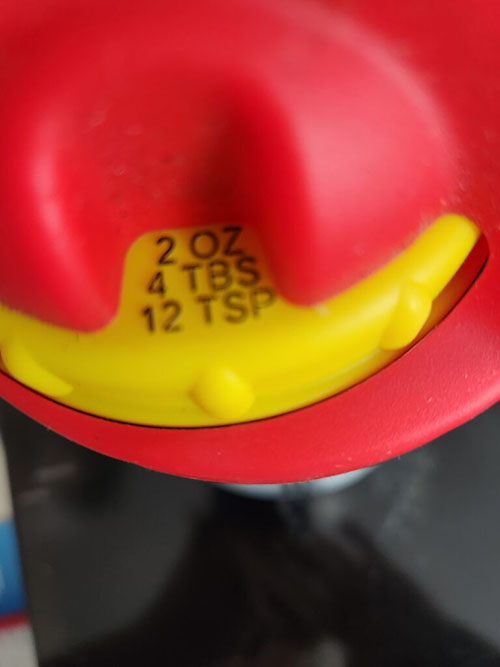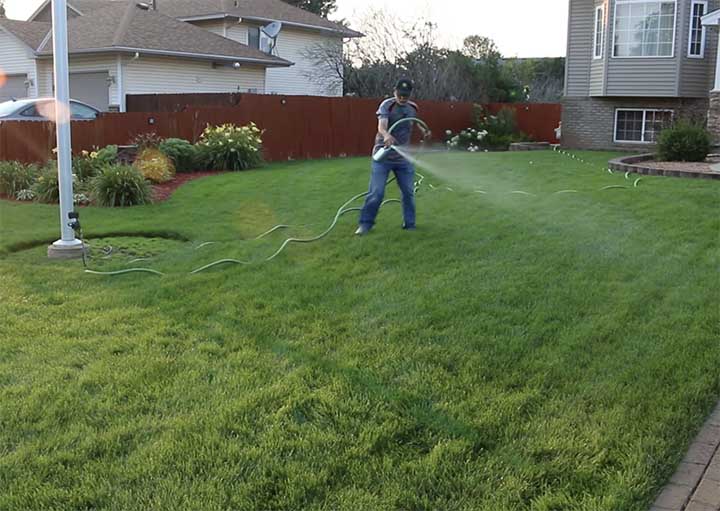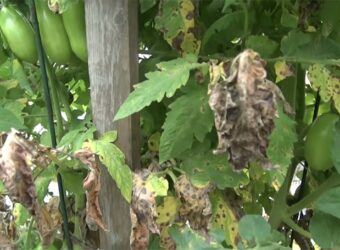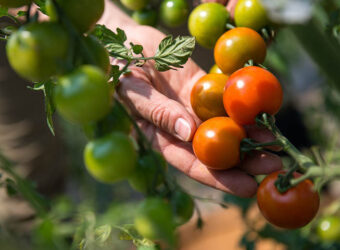Need help figuring out what fertilizer is best for your plants?
This guide will explain what 16-4-8 fertilizer is, what to use it on, and how to use it.
What Is 16-4-8 Fertilizer?
A 16-4-8 fertilizer has sixteen percent nitrogen, four percent phosphorous, and eight percent potassium. The numbers on the front of the fertilizer bag are explained in more detail in this article.
Briefly, nitrogen is important in the production of chlorophyll, which provides the energy for a plant. In addition, nitrogen is in every cell in the plant. Phosphorous helps grow a strong root system and triggers blooms and fruit. Potassium promotes a strong and healthy plant that can resist pests and diseases.
What Is 16-4-8 Fertilizer Used For?
A 16-4-8 fertilizer is frequently used on lawns. It is also used for evergreen trees and shrubs and fruit, nut, and citrus trees.
Why Use 16-4-8?
The high nitrogen content promotes growth and provides a burst of deep green color to lawns. The phosphorous helps with strong roots, and the potassium makes a thick, lush lawn. When applied to trees, the 16-4-8 fertilizer helps promote lots of foliage and good crops for fruit, nut, and citrus trees.
Types of 16-4-8 Fertilizer
Fertilizers like 16-4-8 come in a variety of forms. Here are some of them.
Liquid Fertilizer
Many liquid 16-4-8 fertilizers are applied to lawns, trees, and shrubs by spraying the fertilizer on the plants. Some liquids are concentrates that need to be mixed with water before being applied, while others are ready-to-use. All liquids start working immediately and work for seven to fourteen days.
Water-Soluble Fertilizer
Water-soluble fertilizers are granules or powders that are mixed in water. Because they are in the water, these fertilizers are taken up immediately and last for seven to fourteen days. I have not found a water-soluble 16-4-8 fertilizer.
Fertilizer for Hydroponics
Hydroponics requires liquid nutrients, so water-soluble and liquid fertilizers can be used for growing things hydroponically.
Granular Fertilizer
Granular fertilizers are made up of small granules of fertilizer. Granular fertilizers are easy to spread over a large area with a fertilizer spreader, so they are good for lawns and under the drip line of evergreen trees and shrubs. Some granular fertilizers are slow-release, while others make all their nutrients available immediately.
Organic Fertilizer
Organic fertilizers are made of only natural ingredients. In addition, the fertilizers are certified as organic by a certifying agency such as the USDA. They can be liquid or granular fertilizers. I did not find an organic 16-4-8 fertilizer.
Slow-Release Fertilizer
Slow-release fertilizer is coated with a substance that slowly breaks down over time. Slow-release fertilizers generally take seven days to start working and may last several months.
Spike Fertilizer
Spikes are granular fertilizers pressed into a spike shape. They are hammered into the ground around the drip line of the tree or shrub.
When and How Do I Apply 16-4-8 Fertilizer?
Each 16-4-8 fertilizer is used a little differently depending on the manufacturer and the form it is in. Here are some example application rates.
Houseplants
16-4-8 is not usually used for houseplants.
Annual Flowers
A 16-4-8 fertilizer is not the right fertilizer for annual flowers. They need more phosphorous and potassium than it contains.
Existing Ornamental Plants
Ornamental plants are usually fertilized with a fertilizer with more phosphorous and potassium than 16-4-8 has.
Bulbs and Tubers
16-4-8 is not used for bulbs and tubers for the same reason it is not used for ornamental plants.
Vegetable Gardens
16-4-8 can be used for green leafy vegetables such as lettuce or spinach but not for plants that produce vegetables like cucumbers or fruit like tomatoes. The high nitrogen level will make fruiting vegetables grow too much at the expense of the fruit or vegetable. I use 1-2 ounces per gallon of water and soak the ground around my leafy plants monthly.
If you are looking for fertilizing your vegetable gardens, I recommend you follow my article here.
Evergreen Trees and Shrubs
I spread granules under the dripline every eight weeks. I water the tree after fertilizing it. Alternatively, you can use spikes every three feet on the dripline once in the spring and once in the fall.
Fruit, Nut, and Citrus Trees
I spread spikes three feet apart on the drip line. I use the spikes in the spring and in the fall. Do not use it in the winter or summer.
Alternatively, use one gallon per acre and spray on the leaves of the trees in the early morning so the leaves dry by nightfall. Use every ten days.
Lawns
16-4-8 fertilizer is ideal for all types of turf grass, including Bermuda grass, St. Augustine grass, and zoysia. When using a liquid, apply 2-3 fluid ounces per gallon of water and spray over the lawn. Apply every two weeks.
To use a hose-end sprayer to spray your lawn, follow these steps:

Remove the top of the hose end sprayer.
Place the required amount of fertilizer in the sprayer container. In this case, put two ounces in the sprayer.
Replace the lid of the hose end sprayer.

Change the dial to read “2 oz”.
Put the hose end sprayer on a water hose.
Turn on the water hose.

When ready to spray the lawn, simply turn the toggle switch to “wet”.
For granular fertilizers, spread about 3.6 pounds per 1000 square feet. Use every eight weeks. Many fertilizer manufacturers tell you where to set your spreader dial on your specific model of spreader to release the fertilizer at the proper rate.
Where Do I Buy 16-4-8 Fertilizer?
You can buy 16-4-8 fertilizer from big box stores such as Home Depot and Walmart. You can also purchase 16-4-8 fertilizer from Amazon and online gardening supply places.
My 16-4-8 Fertilizer Recommendations
With many 16-4-8 fertilizers out there, it can be tough to find the best. Here are my recommendations.
16-4-8 Liquid Fertilizer
Nature’s Lawn & Garden – Bio-Enhanced 16-4-8 Liquid Lawn Fertilizer is my pick for the best liquid 16-4-8 fertilizer. This fertilizer is pet safe, which is important to me. Nature’s Lawn & Garden – Bio-Enhanced 16-4-8 Liquid Lawn Fertilizer contains seaweed and humic & fulvic acids to bioactivate your lawn. If you mix this fertilizer as directed, it is guaranteed not to burn your lawn, no matter what turf grass you grow.
As an added bonus, you can use this fertilizer on leafy greens, fruit, nut, and citrus trees to keep them green and growing. I spray leafy vegetables as a foliar spray using 1-2 ounces of water per gallon of water. For fruit, nut, and citrus trees, I spray one gallon per acre of fertilizer on the leaves. I use this fertilizer early in the morning before the dew dries.
16-4-8 Spike Fertilizer
Vigoro All Season Fruit, Nut and Citrus Fertilizer Spikes are my pick for the best spike 16-4-8 fertilizer. These spikes slowly release their fertilizer, so I only have to put them out in the spring and fall. Vigoro All Season Fruit, Nut and Citrus Fertilizer Spikes contain exactly what my fruit, nut, and citrus trees need to grow and produce bumper crops. I like the convenience and cost-effectiveness of these spikes.
To use, I simply put hammer one spike in the ground every three feet of dripline. Afterward, I water the trees as normal. I do that in the spring and in the fall and don’t have to worry about fertilizing my trees otherwise.
16-4-8 Fertilizer – Best Overall
The Andersons Professional PGF Complete 16-4-8 Fertilizer with 7% Humic DG is my pick for the best overall 16-4-8 fertilizer. I like that the particle size is very small, so the particles are easy to spread and cover more turf. The patented Humic DG helps the nutrients reach the root level faster. I use this fertilizer on all types of turf grass every eight weeks during the growing season.
Before using The Andersons Professional PGF Complete 16-4-8 Fertilizer with 7% Humic DG, I mow the lawn and make sure the foliage is dry. After I spread the fertilizer, I water the lawn with a quarter inch of water. I can tell a difference in six to fourteen days and do not have to fertilize again for eight weeks.
What Are the Ingredients in 16-4-8 Fertilizer?
Each manufacturer guarantees the fertilizer will contain sixteen percent nitrogen, four percent phosphorous, and eight percent potassium. Some manufacturers include proprietary ingredients intended to make the nutrients more available to the plants. The rest of the fertilizer is fillers to make spreading the fertilizer easier and some preservatives to keep the fertilizer from spoiling.
Frequently Asked Questions
Is 16-4-8 fertilizer harmful to pets?
A pet will get sick if they eat much 16-4-8 fertilizer. I keep my pets indoors until the fertilizer I spray as a liquid is dry or the granular fertilizer is watered well and then dries. When I had horses, I waited for one cutting before giving the horse the clippings from the yard.
Can you use 16-4-8 fertilizer on St Augustine grass in Texas?
Yes, 16-4-8 is safe to use on St. Augustine grass. I would not use it when it is hot out, and the grass is in heat dormancy but use it in the spring and the fall.
What spreader settings should I use for 16-4-8 fertilizer?
The setting will vary depending on your fertilizer spreader. Most fertilizer bags list the spreader setting for common models of fertilizer spreaders on the label.
Is 16-4-8 fertilizer the same as ammonia nitrate?
No, it is not. Ammonia nitrate does not contain any phosphorous or potassium. In addition, it is very explosive.
In conclusion, 16-4-8 fertilizer is primarily used for turf grass, evergreen trees and shrubs, and fruit, nut, and citrus trees. The fertilizer comes as a liquid, granule, or spike. The liquid is sprayed on the lawn or tree leaves and has to be reapplied frequently. Granules are usually spread with a fertilizer spreader and do not have to be applied as often. Spikes are granules formed into a spike that is hammered into the ground around the tree’s drip line. Any form of 16-4-8 produces lots of growth and green lawns and leaves.






